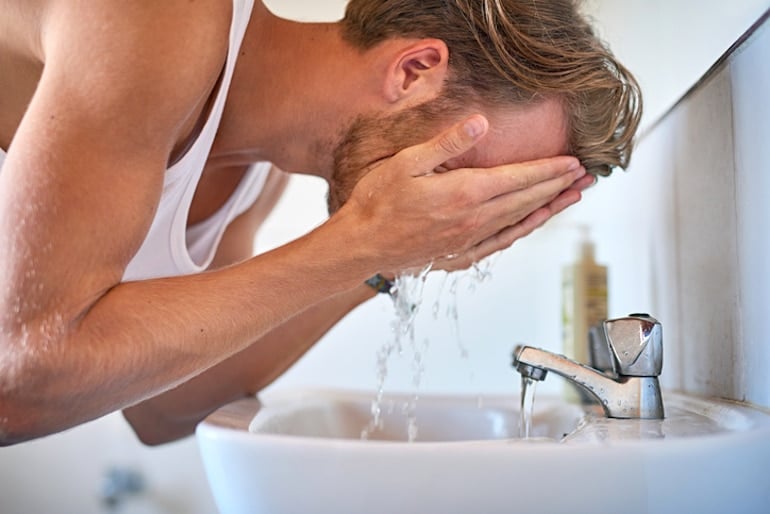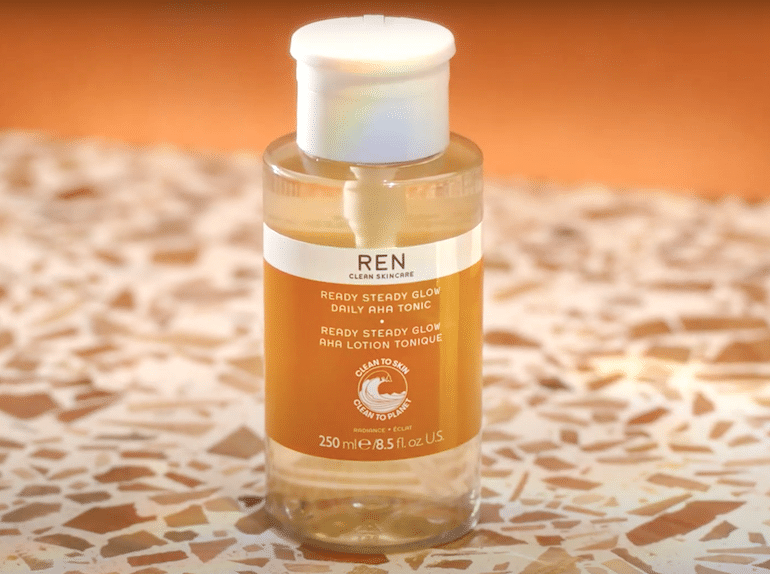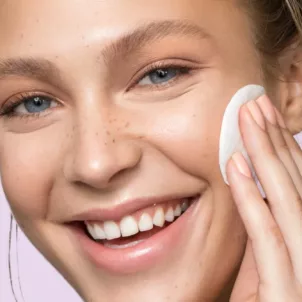Our friends at REN Clean Skincare teach us about the benefits of lactic acid, one of the best exfoliators for sensitive skin.
We’ve said it before and we’ll say it again: Regular exfoliation is key to achieve and maintain an even skin tone and healthy glow. That said, dry and sensitive skin types may be reluctant to scrub or sud with active ingredients.
However, there’s no cause for concern once you know how to exfoliate sensitive skin safely and with the right ingredients. Enter: lactic acid skincare.
To learn more about this gentle exfoliating ingredient, we spoke with David Delport, the Global Head of Education at REN Clean Skincare.


Is it safe To Exfoliate dry + sensitive skin?
First, David gives the go-ahead to exfoliate dry skin, “especially if the skin’s surface is looking and feeling patchy and flaky.” However, he says, “sensitive skin is sometimes another issue.” “Sensitive skin often overproduces cells to heal, but those cells don’t ‘settle,’ leaving a flaky, dry appearance. Essentially, it’s like an escalator on overdrive,” David explains. Before starting an exfoliating regimen, he advises getting skin back to its normal balance. Above all, take measures to restore your skin barrier and prevent further inflammation. Top tips include:- avoiding abrasive ingredients (go clean when possible)
- opting for replenishing formulas
- hydrating and moisturizing

What does lactic acid do for skin?
“All exfoliators have their place and time,” David begins. But “given its more gentle nature and larger molecule size,” lactic acid is well-suited for all skin types—yes, even sensitive skin. And it turns out that research agrees. A 2018 study shows that lactic acid is among the best exfoliators for sensitive skin, since it:- acts as a potent antioxidant
- is an excellent moisturizer
- maintains skin barrier integrity
Lactic Acid Vs. Other Exfoliators
Curious as to how lactic acid sizes up to other types of exfoliators? Here’s a quick look at it compared to (and mixed with) others.Glycolic Acid
First we have glycolic acid, arguably the most popular AHA. “Glycolic works faster and deeper, but can put skin into more of a ‘shock,'” David explains. While normal and oily skin types often better handle this heavier-duty skincare ingredient, dry and sensitive types should typically steer clear.Physical Scrubs
Then there are classic exfoliating scrubs, which polish dead skin cells through manual buffing. “Scrubs are [particularly] great for guys and or getting into facial hair and beards,” he continues. However, he adamantly says that anyone with broken skin or breakouts should avoid using scrubs until they heal or clear up. All said, the three can work in harmony, so long as your skin can tolerate it. “Personally, I do scrubs before I shave, lactic acid almost daily, and reserve glycolic acid for a once-weekly booster treatment,” David shares.Azelaic Acid + Salicin
REN’s best-selling toner, Ready Steady Glow Daily AHA Tonic, pairs lactic acid with azelaic acid (another AHA) and salicin (a beta-hydroxy acid, or BHA). The potent yet non-irritating formula not only exfoliates sensitive skin, but also brightens, tightens, clears, and hydrates. “The azelaic acid precursor is awesome for targeting uneven dark marks as well as breakouts,” David shares. Meanwhile, “salicin is an oil-soluble BHA, meaning it can get into your pores to clean them out, therefore reducing and preventing breakouts.” After all, who doesn’t love a product that works overtime?
How often should you exfoliate sensitive skin?
First, it’s important to remember that everyone’s skin is different. For that reason, David advises patch testing with any new product and then paying attention to how your skin reacts. “You’ll know if you’re pushing it too far,” David says. Plus, the last thing sensitive skin needs is over-exfoliation. That said, he shares that some people are able to build up to daily exfoliation, while others can still benefit from exfoliating two or three times per week. He concludes that your skin should glow while still feeling comfortable.The Bottom Line
All said, lactic acid may very well be the best exfoliator for sensitive skin. It’s doesn’t only speed up skin cell renewal and turnover, but also quenches dryness and promotes skin barrier health. So, what are you waiting for? It’s time to exfoliate and get glowing. For more clean skincare recommendations and tips, be sure to follow REN Clean Skincare on Instagram.More like this









